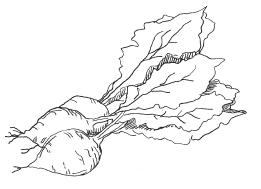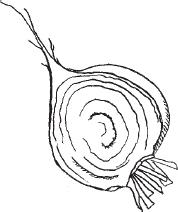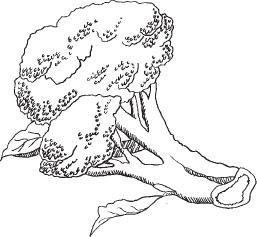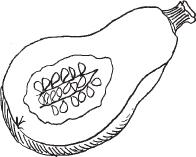Nourishing Traditions: The Cookbook That Challenges Politically Correct Nutrition and The... (104 page)
Authors: Sally Fallon,Pat Connolly,Phd. Mary G. Enig
Tags: #Non-Fiction, #Reference, #Science, #Health
Bean Sprout Curry
Serves 4
1 bunch green onions, finely chopped
2 stalks celery, finely chopped
¼ green pepper, finely chopped
1 apple, peeled and chopped
4 tablespoons butter
1½ cups
chicken stock2 tablespoons arrowroot mixed with 2 tablespoons filtered water
1 tablespoon curry powder
pinch cayenne pepper
½ cup currants
3-4 cups bean sprouts
finely chopped
crispy peanuts
for garnishfinely chopped chives for garnish
Melt butter in a large, heavy skillet. Saute onion, celery, pepper and apple about 1 minute. Add stock, currants, seasonings and arrowroot mixture. Saute, stirring, until liquid begins to thicken. Add sprouts, mix well and cook until just tender, about 1 minute. Serve with
basic brown rice
and garnish with peanuts and chives.
Beets were developed by German gardeners in the Middle Ages. Long valued as a blood tonic, they are rich in calcium, iron, magnesium and phosphorus, as well as carotene, B complex and vitamin C.
Beets are so concentrated, nutritionally speaking, that many natural vitamins are derived from them. Dr. Bruce West recommends eating a few spoonfuls of beets per day—either raw, fermented or cooked—as a sure method of ingesting adequate vitamins and minerals on a regular basis and as a way of detoxifying the body as well. Beets and their tops contain special substances that protect the liver and stimulate the flow of bile. Beets and beet juice have been used successfully in cancer therapies.
Beet tops contain the same nutrients as the root with the added bonus of an exceptionally high carotenoid content. Always buy beets untrimmed as the leaves are a good indication of freshness, and make a habit of eating beet roots with their tops. The combination is excellent, nutritionally speaking, and the sweet beets are a good complement to their bitter greens. SWF

BEETS
Remove leaves, wash, and place in a heavy pan. Meanwhile, cut stems off the beets. There are two ways of cooking them. One is to cover with water and boil until tender. The other is to bake in a 250 degree oven for 2 hours or so or until tender. The later method is preferable from the nutritional point of view, but it takes longer. Peel the cooked beets, slice them and transfer to a heated serving bowl. Meanwhile, cover the greens and simmer on lowest heat. (Do not add water as the moisture adhering to the leaves is sufficient to steam them.) As soon as greens are wilted, remove to a strainer or colander. Press out the juice, chop the leaves coarsely and mix with sliced beets. Toss with a pat of butter or with a little butter that has been melted with one mashed clove of garlic and a squeeze of lemon juice.

BROCCOLI
Broccoli not only ranks number one in nutrient content, it is also the easiest vegetable of all to prepare. Cut into flowerets and steam about 5 minutes or until broccoli has turned bright green and is just tender. Transfer to a heated serving dish, top with a generous pat of butter and keep warm in the oven.
Broccoli Timbales
Serves 6
1 large bunch broccoli
4 tablespoons butter, softened
4 tablespoons
piima cream
or
creme fraiche4 eggs, lightly beaten
1 small onion, very finely chopped
½ teaspoon sea salt
¼ teaspoon pepper
Steam broccoli according to the master recipe. Place in food processor and pulse a few times until well chopped. Add butter, cream, eggs and onion and blend well. Season to taste. Pour into six well-buttered conical timbale molds. Place in a pan of hot water and bake at 350 degrees for 20 minutes. Loosen timbales with a knife and turn onto a warmed platter or individual plates.
Broccoli tops the list of common vegetables for nutrient content. It is high in carotenoids and vitamin C and contains B complex, calcium, phosphorus and potassium as well. New research reveals that broccoli is rich in chromium, a mineral that protects against diabetes. It contains some protein and is a good source of fiber. Like all vegetables of the crucifer family, broccoli is rich in indoles, a potent anticancer substance, as well as such antioxidant and anticancer agents as quercitin and glutathione. Not surprisingly, many studies show that broccoli is the preferred vegetable among those with lower rates of all kinds of cancer. Organic broccoli is now almost universally available—it is, of course, superior in taste and nutrient content to broccoli grown with high-nitrate fertilizers. SWF
The more defective this individual biochemical makeup is, by inheritance, enzyme deficiency, malnutrition, harbored infection or otherwise, the more likely the person is to develop maladaptive, allergic-like symptoms on exposure to food and environmental contacts. Our peculiar cultural preferences for eating only a few types of food, for example, or our heavy consumption of refined carbohydrates. . .add materially to a developing state of nutritional deficiency with a corresponding multiple symptom production in our body tissue systems. Likewise, our nation's propensity to consume nutritionally deficient junk foods further increases the defective tissue states in the human body. These defective states undermine an individual's ability to handle without symptom formation the contacts he has with toxins, pollens, foods or chemical fumes. William H. Philpott, MD
Victory Over Diabetes

BRUSSELS SPROUTS
Cut tough ends off the sprouts and remove loose outer leaves. Make a little cross in the end. This will help the sprouts cook more evenly. Steam for 5 to 10 minutes until just tender—do not overcook! Transfer to a heated serving dish and top with a pat of butter. An alternate method is to cut the sprouts lengthwise into quarters, steam them about 1 minute and then saute in a mixture of butter and olive oil.
First planted in America by Thomas Jefferson, Brussels sprouts are a flavorful winter vegetable that can be ruined by overcooking. They contain a similar vitamin profile to other members of the cruciferous family; namely, carotenoids and vitamin C along with the minerals phosphorus and calcium. Like cabbage and broccoli, Brussels sprouts contain a host of anticancer substances.
To remove insects from Brussels sprouts, cauliflower, artichokes, etc., soak thirty minutes in water to which 2 tablespoons of salt and vinegar have been added. Rinse well and proceed with cooking. SWF

BUTTERNUT SQUASH
Cut squash in half, remove seeds and set cut side down in a buttered glass baking pan with about ½ inch of water. Bake at 350 degrees until tender, about 1 hour. Meanwhile, melt equal parts of butter and raw honey together in a pitcher set in hot water. (Don't let the mixture surpass 118 degrees or the valuable amylase enzymes in the honey will be destroyed.) To serve, place cut side of squash up and pour a little honey-butter mixture into each cavity.
Butternut Squash Puree with Pecans
Serves 63 butternut squash
3 eggs, lightly beaten
¼ teaspoon nutmeg
sea salt and pepper
2 tablespoons butter
¾ cup
crispy pecans
, chopped
Cook the squash as described above, scoop out into a food processor and blend until smooth. Add eggs and nutmeg and season to taste. Transfer puree to an ovenproof serving dish. Melt the butter and pour over the puree. Sprinkle on pecans. Bake at 350 degrees for about 30 minutes.

Why did the McGovern Committee ignore the scientific literature incriminating vegetable fats in atherosclerosis? Extensive studies with monkeys fed vegetable oils proved beyond a doubt that peanut oil. . .and other vegetable fats cause severe hardening of the arteries. With the current fixation on cholesterol in the nutritional establishment, it is important to note that on peanut oil the serum cholesterol remained low. The peanut oil may kill you, but you can die with a normal cholesterol. William Campbell Douglass, MD
The Milk Book